PARK SEO-BO Korean French abstract Ecriture painting artists paint box
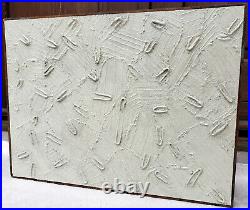
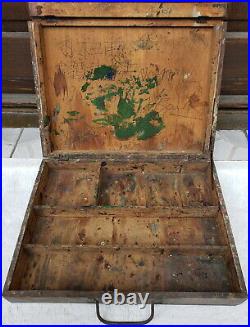
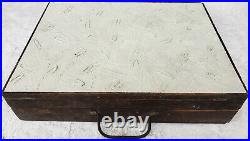

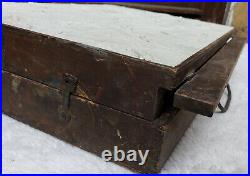
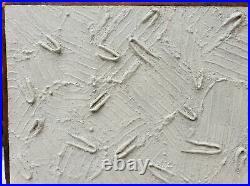
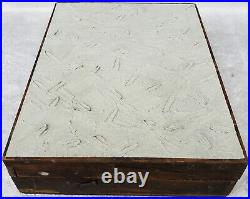
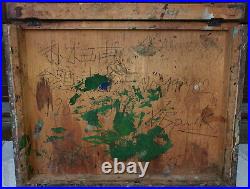
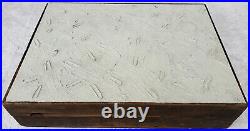
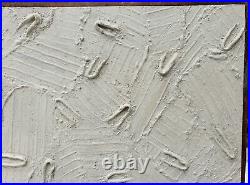
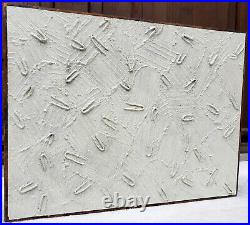
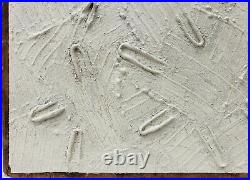

Antique minimalist painting on artist's wooden paint box. Early Ecriture Zigzag bone color artwork.
Mixed media with Korean hanji oil etc. Signed, titled and dated 1982 in Korean inside the box.
Artist paint box age circa 1920-30's. Dimensions: 40cm X 30cm X 9cm «» 15,75" X 11,81" inches Provenance Collection privée, France, Paris. Some small networks of drying cracks but very stable, just a couple of fabulous photos should say it all. Awesome painting; texture and details are very unique. The effect can be like marks on drying concrete. Light patches of once-wet white hanji paper have a water-damage feel, echoing time passing. Park Seo-bo (also known as Korean: , Park Seo-Bo or Seo-Bo Park) is a Korean painter, part of the first generation of modern artists in South Korea. He has been a prolific painter well known for his'French: Ecriture' paintings, and has been one of the most influential figures in modern Korean art history. He is now widely considered the godfather of Dansaekhwa originated in South Korea in 1970s.Park Seo-Bo is widely considered one of the leading figures in contemporary Korean art. Born in 1931 in Yecheon, Gyeongbuk, Park was part of a generation that was deeply affected by the Korean War (195053) which divided the country into North and South. After experimenting with Western abstraction, particularly the style of Art Informel with which he became familiar during his time in Paris in 1961, Park began to explore a more introspective methodology that had its origins in Taoist and Buddhist philosophy and also in the Korean tradition of calligraphy.
Park is best known for his Ecriture series of paintings. First begun in the late 1960s, the Ecriture series embrace this spiritual approach and are inextricably linked to notions of time, space and material, concepts which underpin all of the artists work. In the early works, Park used repeated pencil lines incised into a still-wet monochromatic painted surface, and the later works expand upon this language through the introduction of hanji, a traditional Korean paper hand-made from mulberry bark, which is adhered to the canvas surface.
This development, along with the introduction of colour, enabled an expansive transformation of his practice while continuing the quest for emptiness though reduction. Hundreds of sales prove it. Zigzag, the second show by Park Seo-Bo at White Cube Masons Yard in as many years, owes much to this growing taste for austere yet aesthetically pleasing work with an emphasis on process.However, the proliferation of Western interest in a group of artists who had previously gone largely unnoticed outside of Korea, and on whom relatively little is written, risks couching practices such as Parks in the language of an art history that is not their own. Western art certainly influenced the movement in which Park played a key role, lending its materials and procedures if not its aesthetic and philosophical rationale.
It was he, in fact, who brought the principles and techniques of Western abstraction to Korea when he founded the Korean Modern Artists Association in 1957. This said, the works in Zigzag, and the rest of the 50-year Ecriture series (1967) to which they belong, must be considered on their own terms to be meaningfully experienced, if not understood. It is especially egregious to equate this work with minimalism, the efforts of whose practitioners constituted a reaction against tradition, as the Dansaekhwa artists sought rather to engage with a notion of the past, one underpinned by an aesthetic, societal, and philosophical understanding of nature. In the pieces displayed at White Cube, this engagement relies not on a process of abstract reductionism, as in minimalism, but of cumulative layering.
Although Park practices a style of reduction towards an expression of nature that he calls pure emptiness, this emptiness is not expressed in the optical qualities of the canvases, but in the iterative processes they document. The Zigzag pieces, created in the 1980s and early 90s, cannot rightly be called paintings.
Unlike his earlier oil-based Ecriture works, they employ hanji a traditional Korean paper made from mulberry barkwhich is soaked in water and layered onto the canvas with pigment. The artist then scratches recursive patterns into the surface with a variety of implements before pinching the raised edges with canvas pliers. Unlike Western paper, which is written on , here the unique texture and cultural significance of hanji mean that it may be written with. In trying to categorize these artworks, the name Ecriture is itself layered with irony; by referencing a formalized system of encoding and interpreting the world, it risks undermining any direct appeal to the pure emptiness of nature.
The name may be better understood through comparisons between Parks work and calligraphy, the Taoist understanding of which places emphasis not on the text, but on a contemplation of the strokes that created it. Such a meditative focus on highly repetitive gestures is crucial to experiencing these works.
It provokes a feeling of semantic satiationas when an excessively repeated word loses its meaningand dissolves both visual and verbal language. This dissolution hints at an enigmatic universal truth, but over time the iterative act also establishes a process and aesthetic, exceptions to which become repudiations of that universality and imply specific natural phenomena.
931204 , 1993, mixed media with Korean Hanji paper, 46 × 53.5 cm. Courtesy White Cube, Hong Kong. Such anomalies appear in the selective use of line and pigment: three subtle lines, breaking the ubiquitous zigzag pattern on a sand-colored canvas, evoke the lapping of shallow water as well as all the forces of light and tide that go with it; the pigment patching another canvas recalls metal ore and oxidization; elsewhere, a vivid red glows through dark, basaltic gray and suggests smoldering heat. These applications of pigment should not be understood as describing the color of things, but the nature of things.
Écriture s these are not. Despite the title of the series to which the artworks in Zigzag belong, they deal not in language, but in its dissolution. In the emptiness of effable meaning achieved through copious repetition, these canvases seek a common referent with a natural world whose processes are repetitive and wordless. With further retrospectives likely on the horizon, it speaks to Parks credit that, having made repetition his business over five prolific decades, the work here remains anything but tedious.
Park Seo-Bo in his junior year at Hongik University in 1953 right after the ceasefire agreement of Korean War. However, his happy freshman year was interrupted by the outburst of Korean War.
He narrowly survived the war time chaos, experiencing his father's abrupt death, drafts both by North Korean and South Korean forces and long winter evacuating on foot from his hometown Anseong. Seo-bo barely managed to go back to school in 1952. Hongik University temporarily moved to Busan. He enrolled for the second year and changed his major to western painting because his professors of oriental painting were all gone. He learned painting from scratch under the lead of Whanki Kim.
For 3 more years and graduated in 1955. Although the ceasefire was announced in 1953, the whole country were suffering from poverty and immorality. Seo-bo was not different from them. He did paintings or drawings with the last drops of oil paint tubes and little pieces of charcoal that his classmates discarded and sometimes even with soy sauce he stole from a restaurant. He thought there was nobody to rely on in the world. He worked harder and harder for future success. However, he became a fugitive. Although he completed his military service at Corps of Military Staff Clerks.During the last semester, the government of Syngman Rhee. Broke its promise to let the Korean Army conscript the male graduates at the graduation ceremony. Informed by his friends at other universities, Seo-bo did not go to the ceremony and ran away immediately. He went to his friend with great knowledge about Chinese classics.
To ask to make up a new name for him. From that time on, Seo-bo pretended to be in his late 30s, wearing a fedora with a mustache and was called by the pseudonym.
He even brought his best friend Kim Tschang-yeul. As a bodyguard on his honeymoon trip along with his bride because he was a policeman. 1958 Park Seo-Bo with his colleagues at the 3rd Contemporary Exhibition of Hyun-Dai Artists Association in Seoul, South Korea in 1958. He received a prize at the Korean National Art Exhibition in 1954 as a student and again in 1955.
However, the National Art Exhibition had been never free of troubles since it was established in 1949. Seo-bo declared objection to the National Art Exhibition with three of his school friends and opened their own group exhibition in 1956.That caught public attention and the newspapers spotlighted the young artists' defiance. From 1957 to 1960, Seo-bo participated in group exhibitions of Hyun-Dai Artists Association where he became close with Kim Tschang-yeul. The Hyun-Dae Artists Association is well known for initiating Informel.
For the first time in Korea. Park Seo-Bo stands in front of his painting Original Sin (Péché originel) at the group exhibition of the Young Painters of the World in Paris. He got married in 1958 and became a father to his first son Seung-jo in 1959. He did not get a proper job because he was a wanted draft evader.
It was the time when modern paintings did not sell. His wife and child were suffering in poverty.
Seo-bo needed a break-through in his life. So he left for Paris without hesitance when he was selected as a national representative young artist for the Young Painters of the World. It was a residency program organized by the French National Committee of International Association of Art. When he came back from Paris to Seoul, he started teaching at Hongik University. However, he became a scapegoat in dynamics between professors and the private school foundation, which led to his resignation.
Out of work, he stayed at home and happened to discover his life-long topic of resignation and self-discipline while observing his 3-year-old second son, Seung-ho. Since 1967, Seo-bo made an attempt on his first work of his signature style Ecriture.
In 1970, he was called back to professorship at Hongik University and served for education until he retired in 1997. He was the dean of the Graduate School of Fine Arts, Hongik University from 1985 to 1986 and the dean of College of Fine Arts from 1986 to 1990. He received an honorary doctorate from the same university in 2000. Birth of Ecriture and Contemporary Art Movement. In addition to his commitment to education, he also worked hard for the Federation of Artistic & Cultural Organization of Korea for 10 years in 1970s and held the post of chairman from 1977 to 1980.
He organized new forms of exhibition such as "Ecole de Séoul" (19751999) and "Indépendants"(19731980) and Contemporary Art Festivals at each local cities. When he failed the election for a second term in office, he completely concentrated himself on painting in his new studio in Anseong. There he came across to the Korean paper.
"Hanji" and his "Ecriture" transformed. Art historians agree to divide his Eciture series into three phases of initial stage, middle stage, and last stage. "Ecriture" with Hanji appear both at the middle stage and the last stage. More than 150 pieces of "Ecriture" on canvas were burned in an accidental fire of his Anseong studio in 1996.
He had a new studio with a living space built in Sungsan-dong, Mapo-gu, Seoul in 1997 and moved his home to that building in 1999. He was near to death because of myocardial infarction in 1994, and again luckily survived a sudden attack of cerebral infarction in 2009. Park Seo-Bo and his party of the 1st Ecole de Seoul at the 1st exhibition in 1975.He founded the Seo-bo Art and Cultural Foundation, Seoul in 1994 and had remained its president until his first son took the position in 2014. He had his second retrospective exhibition at National Museum of Modern and Contemporary Art in Seoul in 2019. He lives at his new house in Yeonhui-dong, Seoul. With his wife and the family of his second son and is still working on paintings to be active against his aging and chronic diseases. He has two sons and one daughter with three grandchildren.
Park's visual language begins with the Korean Civil War. He had only just entered Hong-Ik University to study art, but instead the interruption of war brought about what one might call a "crash-course". Just imagine, I had to do all the things that Dada did, plus what the post-war abstraction artists did - there are some things you cannot do anything about in life - but I guess it was just my fate. In a similar vein to Paul Klee.S famous words, "The more horrifying this world becomes (as it is these days) the more art becomes abstract", Park turned toward abstraction in the 1950s. None of his works from the early days of his career were preserved, and only a photograph of his work, Sunny Spot (1955) remains. The artwork was part of an infamous exhibition titled Four Artists' Show in May 1956, which was a group exhibition composed of Park, Kim Young Whan, Kim Choong Sun and Moon Woo Shik. The show was a resistance against the old art order in Korea that had its roots since the Japanese colonial days.
Park and his tutelage of artist friends founded Hyundae-Mihyup in 1957. Bang Geun Tack, who will later become a well-known art critic in Korea, recognized Hyundae-Mihyup's art as Informel. Cheon Seung-Bok, a journalist for the Korean Republic, describes Park's artistic style as such. In a grammatical sense, I must say that it is hard to call his work painting, for he is a conscious action painter who tackles curious metal and chemical material and not much real paint, which is too dear for him to use.But to say that action painting like his is recondite, and therefore it is not painting, is like saying that advanced mathematics like differential calculus is not in the field of mathematics. Seo-Bo never buys normal canvases. Instead, he goes out to a scrap shop in an odd corner of the East Gate second-hand market where he picks up a large patch of used tent canvas. This canvas material is usually full of dust and holes but the price is very reasonable for this artist who can hardly sell even one painting a year.
How does he paint a picture? A maggot in his head bites while he rasps dust off the home-made canvas. Then he needles some pieces of used hemp cloth onto the canvas, cements them, pastes copper or bronze powder, burns the surface with a torch lamp, and then corrodes parts of it with chemicals. The result is a complex of material in greyish black, white and on some spots, shimmering red, and this bears an air of mystery that conveys something like the undecipherable signature of a shaman.
People complain that paintings like his are hardly understandable. A painting is silent, but a good painting has compelling voices of silence. With these voices, an action painter must communicate the continuous dichotomy between the desire to give direct expression to a feeling and the desire to create pure harmony, which is a conflict inherent to the development of modern art. Park went to Paris in 1961 with the intention of staying for a short while, but due to unforeseen circumstances, he ended up living in Paris for over a year.
During his time in Paris, his artistic tendency and outlook changed significantly, which ultimately resulted in his exiting the Art Informel scene toward his own artistic formulation, the Primordialis series in 1962. Park's comments on the Parisian art scene was as such. At the moment, the Parisian art scene is saturated with the Art Informel that was initiated by Michel Tapié.This change is viewed by some artists as the signalling of a re-emergence of figuration, and others even say that the reversion to the figurative art is a due course set in the history of art. I think that they are ridiculing its value. It was a lazy way of acknowledging its value. Yes, it is true that Art Informel has pervaded the art scenery. Supposing that you look at it as a crisis, then this "crisis" stems from the contradiction within the abstractive art, and not from the reappearance of the figurative art.
And another indirect reason for the current symptom in the art scene is that many people indiscriminately picked up abstraction. Toward the end of the 1960s, Park began experimenting in new forms, the Hereditarius series. Oh Kwang Soo, art critic, described his works as such.
At the 13th Contemporary Art Exhibition of Chosun Daily Newspaper, there are several artworks which are difficult to understand at a single glance. In Park Seo-bo's work, there is a taxidermic form without the actual human body in casual posture and the image of a emptied human figure on the canvas. The suggestion of these two situations means to convey a condensed happening at a single moment. The gap between the painting on the wall and the posing empty taxidermy signifies the distances (between home and office) and therefore time. Park Seo-Bo working on a piece of his Ecriture at his Hapjeong-dong studio in 1977.
Then in June 1973 at Tokyo Gallery, Park began his ongoing journey through the Ecriture series. This is what Park said at the time.
I painted nothing, my work had no form, no emphasis, and no ins-and-outs, except for the pure vibration coming out of not doing anything an action through non-action. Anyone can draw lines, but my lines are the endemic phenomenon which takes place only in me. I feel and reciprocate the resistance of the bouncy canvas, then I feel replete with an impulsive sensation. In this way I keep being gravitated into the canvas.
It is similar to cultivating the religious spirit... I started from where there was no form, or no image where it was impossible to express. Post-War and Contemporary David Hockney Gerhard Richter Mike Kelley Richard Diebenkorn Peter Busa LeRoy Neiman Alexandra Nechita Peter Max Tran Van Can Mai Trung Thu Akira Kurosawa Liu Haisu George Chann Chang Yu Le Pho Vu Cao Dam Zhao Chunxiang Qiu Zhijie Chu Teh Chun Zao Wouki Sadji Cote d'Azur Monaco Monte-Carlo Bauhaus Hans Hofmann Serge Poliakoff Sanyu Walasse Ting futurism cubism abstract modernism Rockwell Kent Martha Walter Carl Rungius Selden Connor Gile Thomas Hart Benton Walter Schofield Henry Ossawa Tanner Frank Weston Benson Rene Richard Edgar Alwin Payne Joseph Fleck Sheldon Parsons Kenneth Miller Adams Jozef Bakos William Dunton Ernest Leonard Blumenschein Will Shuster Willard Ayer Nash Carlos Vierra Eanger Irving Couse Bert Geer Phillips Oscar Berninghaus Victor Higgins Gerard Curtis Delano Ernest Hennings Homer Simpson Max Ernst Van Gogh Picasso Franz Marc Chagall Ernst Ludwig Kirchner Otto Dix Paul Klee Caspar David Friedrich Albrecht Dürer Hans Holbein Max Liebermann Gerhard Richter impressionism expressionism art deco secession Peter Busa Charles Alston John Little Wenxi Chen Tadeus Kantor Yunhe Wang John Ottis Adams William Forsyth Alfons Walde Otto Stark Wayman Elbridge Adams Keith Haring Bernard Buffet Jean-Michel Basquiat Claude Venard Edgar Alwin Payne E. Charlton Fortune John Millard Ferren Georges Seurat Chaim Soutine Avengers Lego Amedeo Modigliani Georges Rouault Moïse Kisling Henri Matisse Pablo Picasso Vaszilij Vasziljevics Kandinszkij Gustav Klimt Georges Braque Paul Cézanne Joan Mitchell Andy Warhol Mark Tansey Ed Ruscha Frank Stella Yayoi Kusama Kenneth Noland Cy Twombly Wayne Thiebaud Gerhard Ruchter Lucian Freud Tom Wesselmann David Smith Louise Nevelson Carmen Herrera Kim Whanki James Lawrence Isherwood Yayoi Kusama Good Vibes Yoga Zen spiritual SpaceX NASA Moon Mars Galaxy Blue Origin Stars antarctic mountains Sun Planet Planets Earth Mercury Venus Jupiter Saturn Uranus Neptune Star Wars Solar System Squid Game pop art.
The item "PARK SEO-BO Korean French abstract Ecriture painting artists paint box" is in sale since Friday, November 19, 2021. This item is in the category "Art\Paintings". The seller is "patent" and is located in Budapest.
This item can be shipped worldwide.
- Size: Medium (up to 36in. )
- Handmade: Yes
- Artist: Park Seo-bo
- Production Technique: Mixed media
- Framing: Unframed
- Country/Region of Manufacture: Korea, Republic of
- Style: Abstract expressionism
- Material: Mixed media
- Type: Painting
- Title: Zigzag Ecriture
- Features: Signed
- Subject: Zigzag Ecriture
- Painting Surface: Wood
- Color: Multi-Color
- Signed: Yes
- Signed By: Park Seo-bo
- Year of Production: 1982
- Original/Licensed Reproduction: Original
- Unit of Sale: Single-Piece Work
